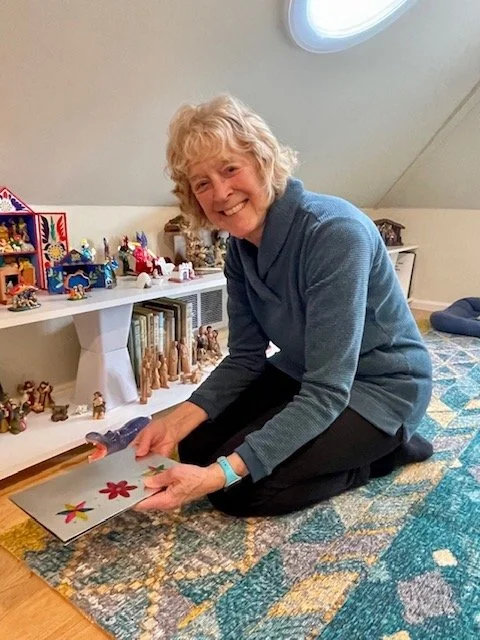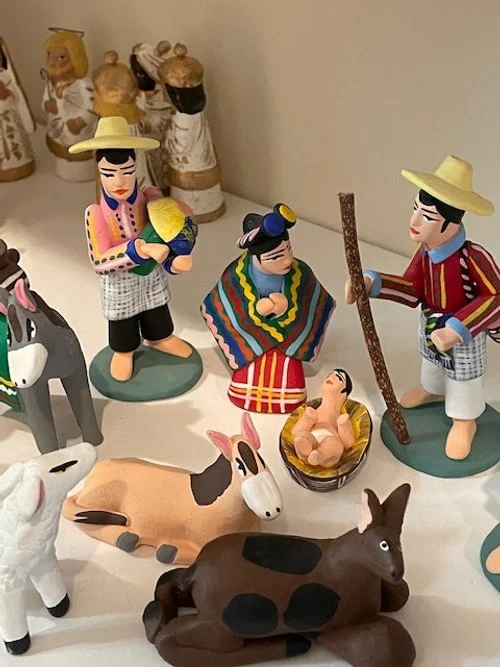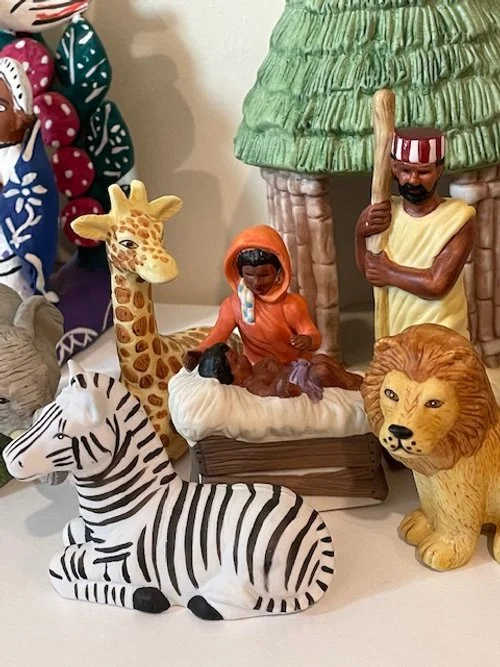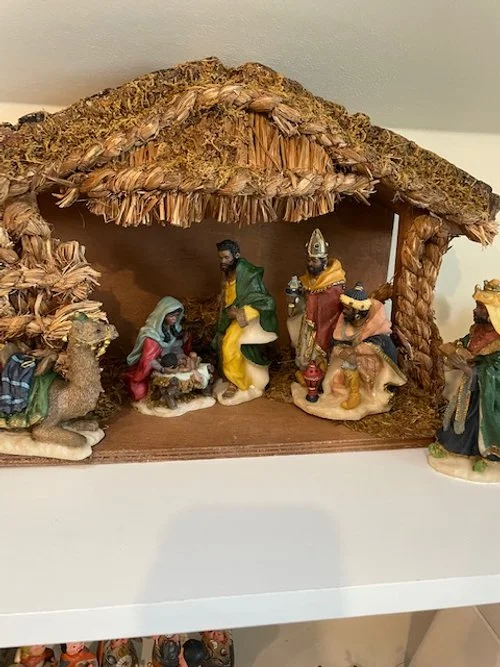Column: Musings of a Nativity Set Collector
Nancy Turner in her happy place.
Story and Photos by Nancy Turner
In 1223 Saint Francis of Assisi created a nativity scene to help children understand the true meaning of Christmas.
He wanted to remind the world that the season was about more than giving and receiving gifts, but rather about celebrating the birth of a special baby.
His depiction of the baby Jesus, Mary and Joseph was set up in a cave in Greccio, Italy using live people and real animals.
This was used to show the world the spirit of Christmas was not be be materialized but to be treasured.
In the 1500s high-class people began displaying nativity scenes in their homes. Artists created versions made of various materials such as wood, wax and fine fabrics. Churches also began displaying creche scenes. Nowadays the sight of nativity in Christian churches evokes the miracle of Jesus' humble birth.
Throughout my childhood, I was the one who set up the family nativity set in mid-December. I acquired my first set as an adult in 1977 when my son was born in December. For the next forty-five years, I've picked sets up at estate sales, second-hand stores and in Mexican and Guatemalan markets.
Guatemalan Nativity Set
The most expensive one is a large glass snow globe with a music box at the bottom that plinks out Silent Night.
That was years ago. I splurged $39.
I've collected nativities made of all sorts of material. Wood, glass, china, plastic, metal, straw, cloth, you name it. One is a traveling set made of metal with figures that collapse flat into a folded envelope of tin. The smallest is carved of stone and measures about an inch across. At first glance several look identical until you notice the fabric of the figures' clothing.
In Guatemala, weavers make cloth particular to their village. One can tell where a person lives by their dress. Hence, my sets from Guatemala might look alike but each one is from a different village.
African Nativity Set
One of the most unique ones is from a junk store in a small town just north of Corvallis. The figures stand about three inches and are African American. A giraffe, zebra, and lion surround the mud hut.
Five years ago as I packed my belongings to move from a large house into a small apartment, I counted over one hundred sets.
Good grief.
My movers were undocumented refugees from El Salvador and belonged to a local Christian church. When I asked how many families were in their congregation the men shrugged their shoulders but their wives knew. I quickly was able to unload thirty sets.
They were delighted, and I was happy too.
Why my fetish for creches? I rationalize that I was attracted to their artistic and ethnic qualities. They are small and easy to store. The largest one was handmade of clay in Chichicastenango, Guatemala.
The camels accompanying the wise men stand about fourteen inches. People collect baseball cards or dolls or miniature cars, but nativity sets?
It wasn't until I studied Jungian psychology that I began to understand my fascination with these figures.
It wasn't just that I was the one in my family who carefully assembled the family set every Christmas. I learned to look at the nativity set not only as a way of honoring the birth of Jesus, but it is more.
I look at the nativity as symbolic of the self, of representing a whole human, the unconscious psyche of a person. With this point of view, Joseph represents the masculine aspects of our selves. Mary, our feminine side. The baby Jesus represents our vulnerable selves, our great potential for new growth.
I was told the names of the three wise men bearing gifts for the baby were Insight, Intuition and
Inspiration. I have no idea if that's true, but I like it. We all have an internal shepherd that keeps us in line, making sure we don't get lost. The animals signify our instinctual nature. The angel Gabriel sheds light on our spirituality.
Why was Jesus not born in a palace or at least a Hilton Hotel? Well, what could be more modest than a stable? We all have humble beginnings. I don't mean financially, I mean psychologically. In Jungian psychology and dream analysis, the home or house is a metaphor of the self. From this unusual perspective, a stable makes sense.
There is something universally appealing about seeing a mother and father hovering over their newborn baby. Fourteen years ago, my daughter, as a single woman addicted to meth, had a baby in December.
Elena knew she was unable to raise a child. As she put it, “I can barely take care of myself.” She placed her baby for adoption with a lesbian couple in Seattle. Since the baby had been exposed to meth we figured two mothers would be better than one. As a gift to the happy couple, I prepared a nativity set for them. I retired Joseph and inserted a second Mary figure. Two Marys knelt by the manger cradling a sleeping baby.
There are many ways to build a family.
Support Local News
Available to everyone: Funded by readers.
As I write, I'm listening to the song Away in a Manger and marvel at how the story of a birth that happened centuries ago still resonates in our hearts. Even people who are not particularly Christian display a nativity set at Christmas.
I'm with Saint Francis of Assisi.
When we see a replication of this special family we recall the true meaning of Christmas.
May we have peace on earth and goodwill to all.





